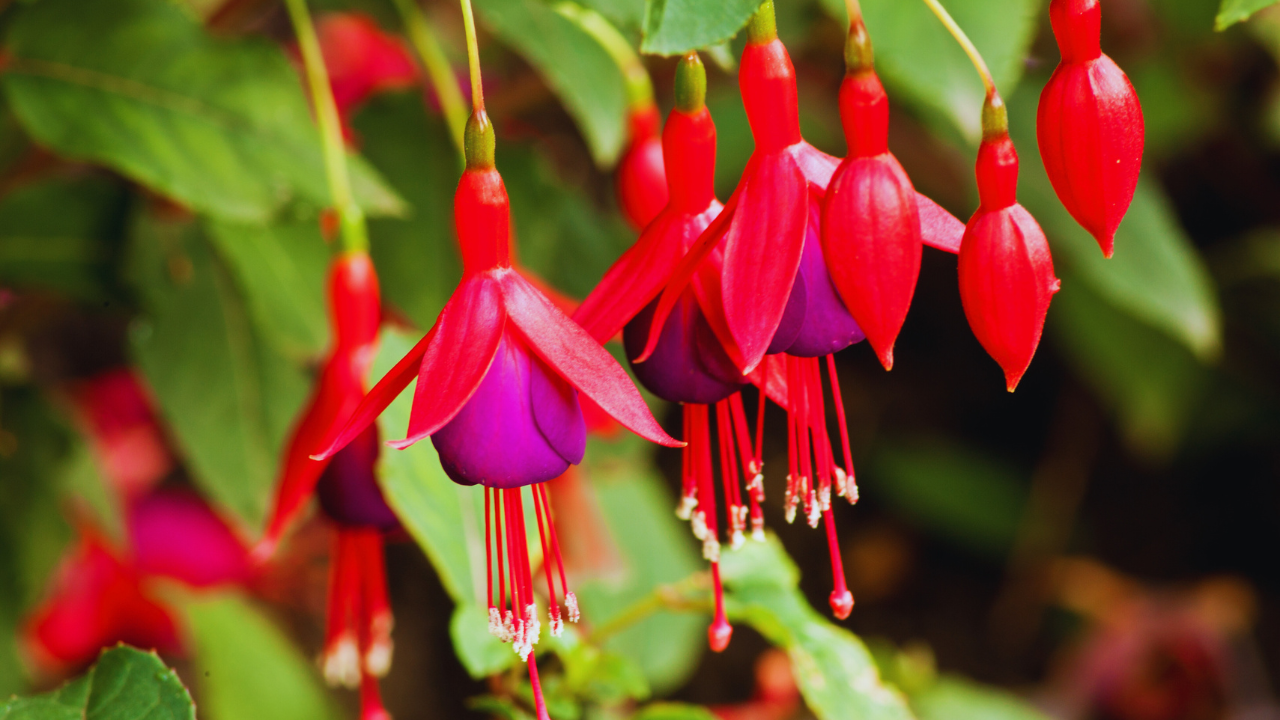Table of Contents

Fuchsia plants are known for their vibrant, bell-shaped flowers that bloom in a variety of stunning colours, ranging from pink and purple to white and red. Whether in hanging baskets, pots, or garden beds, these gorgeous plants add a pop of colour and a sense of elegance to any garden. If you are keen on growing fuchsia in your garden, here’s a comprehensive guide to help you.
1. Choosing the Right Variety
Fuchsia comes in two main types: upright and trailing.
Upright Fuchsia: Ideal for garden beds or containers where you want a vertical growth.
Trailing Fuchsia: Perfect for hanging baskets or containers where the flowers can cascade over the edge, creating a stunning display.
2. Ideal Growing Conditions for Fuchsia
To ensure your fuchsia thrives, you need to provide it with the right conditions:
Light: Fuchsias prefer partial to full shade. Too much direct sunlight can scorch the leaves and flowers. However, they can tolerate morning sun if grown in cooler climates.
Soil: Well-draining soil is essential for fuchsia. They prefer slightly acidic soil (pH 5.5-6.5) that is rich in organic matter. A mix of garden compost and peat moss works wonders.
Temperature: Fuchsia prefers cool to moderate temperatures. They thrive in temperatures between 18°C and 24°C but can struggle in extreme heat.
Humidity: These plants like moderate humidity levels. Dry air can cause the flowers to drop prematurely, so misting or adding humidity is beneficial, especially indoors.
3. How to Plant Fuchsia
Whether planting in the ground or in containers, the process is simple:
In Garden Beds:
1. Dig a hole twice the size of the root ball.
2. Add organic compost to the hole to improve soil quality.
3. Place the fuchsia in the hole and backfill with soil, ensuring the base of the plant is level with the ground.
4. Water well after planting.
In Containers:
1. Choose a well-draining pot.
2. Fill the pot with a quality potting mix and organic compost.
3. Place the plant in the pot, ensuring it's not planted too deep.
4. Water thoroughly after planting.
4. Watering and Feeding Fuchsia
Watering: Fuchsias require regular watering to keep the soil consistently moist but not soggy. In warmer months, they may need watering once or twice a day, while in cooler weather, you can reduce the frequency.
Feeding: Use a balanced liquid fertilizer (10-10-10 or 20-20-20) every two to four weeks during the growing season (spring through fall). Reduce feeding during winter when the plant goes dormant.
5. Pruning and Deadheading
Pruning fuchsia helps maintain its shape and encourages new growth.
Deadheading: Regularly remove spent blooms to promote continuous flowering. Simply pinch off the flowers just below the base.
Pruning: Cut back the plant in early spring to promote healthy growth. Trim about one-third of the plant’s branches, focusing on weak or dead stems.
6. Pest and Disease Control
Fuchsias can be prone to pests like aphids, spider mites, and whiteflies. Keep an eye out for these common problems:
Aphids: These small insects suck sap from the leaves, causing them to curl and wilt. Use insecticidal soap or neem oil to control them.
Spider Mites: Fine webbing on the undersides of leaves is a sign of spider mites. Misting the plant regularly can help prevent these pests.
Whiteflies: Small white insects that fly around when the plant is disturbed. Yellow sticky traps or a strong stream of water can help reduce their population.
Diseases like root rot can occur if the plant is overwatered or if the soil doesn’t drain properly. Ensure good drainage and avoid waterlogged conditions to prevent this issue.
7. Overwintering Fuchsia
In cooler climates, fuchsias may need some extra protection during winter.
In-ground plants: Apply a thick layer of mulch around the base to protect the roots from freezing temperatures.
Potted fuchsias: Bring the pots indoors or into a greenhouse. Keep them in a cool, frost-free place and reduce watering, allowing the plant to go dormant.
8. Propagating Fuchsia
Fuchsias can be propagated easily from cuttings.
1. Take 3-4 inch long cuttings from a healthy plant.
2. Remove the lower leaves, leaving just a few at the top.
3. Dip the cut end in rooting hormone and place it in a pot with a mix of peat and perlite.
4. Keep the soil moist and cover the pot with a plastic bag to retain humidity.
5. In 4-6 weeks, the cutting should develop roots and can be transplanted to a larger pot or garden bed.
9. Common Problems and Solutions
Flower Drop: If your fuchsia drops its flowers prematurely, it may be due to overwatering, underwatering, or extreme heat.
Yellowing Leaves: This can indicate poor drainage, overwatering, or a nutrient deficiency. Adjust watering and feed the plant regularly.

